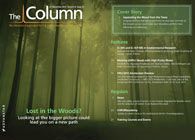Bladder cancer
A group of scientists in Taiwan1 has identified micro-particles within human urine that could be used for the non?invasive diagnosis of bladder cancer.
A group of scientists in Taiwan1 has identified micro-particles within human urine that could be used for the non‑invasive diagnosis of bladder cancer. The occurrence of bladder cancer is rising every year, with the American Cancer Society 2 estimating that 73, 510 new cases of bladder cancer will be diagnosed by the end of 2012. The main methods of diagnosis are urine cytology and cytoscopy. Cytology is of low sensitivity when used as a diagnostic tool because it is poor at detecting low-grade bladder cancers, and cytoscopy is a highly invasive diagnostic procedure.
The team took urine samples from hernia patients (as a control) and bladder cancer patients and observed the differential expression of proteins within urine micro‑particles found in each of the samples. To do this, they utilized isotopic dimethylation labeling coupled with liquid chromatography–multiple reaction monitoring-mass spectrometry(LC–MRM-MS) to identify biomarkers within urinary micro-particles isolated from urine samples collected from hernia control patients and bladder cancer patients. 2,964 proteins were identified to be differentially expressed, present within the samples of either the controls or test subjects but not both, with 2058 novel proteins not previously reported. A total of 29 proteins were determined by statistical analysis to be differentially expressed at a level that made them potentially suitable to be biomarkers in bladder cancer diagnosis. The study quantified tumour-associated calcium transducer 2 (TACSTD2) within the raw urine specimens, confirming its potential use as a biomarker in diagnosis.
The identification of biomarkers has great potential in a clinical setting to reduce the method invasion and the discomfort to the patient in addition to reducing the cost of surveillance.
1. C-L. Chen et al, Journal of Proteome Research, (Accessed 30th of October 2012, www.pubs.acs.org).
2. American Cancer Society (Accessed 1st of November 2012,http://www.cancer.org/).
This story originally appeared in The Column. Click here to view that issue.
Regulatory Deadlines and Supply Chain Challenges Take Center Stage in Nitrosamine Discussion
April 10th 2025During an LCGC International peer exchange, Aloka Srinivasan, Mayank Bhanti, and Amber Burch discussed the regulatory deadlines and supply chain challenges that come with nitrosamine analysis.











